Inventions
William Redgrave’s Safety Travelling Cap
The British patent office granted William Redgrave two patents. The first (No. 2888 - 1853) was for a "safety travelling cap". The second (No. 762 - 1859) was for a "pillow travelling cap". However, the two patents seem to describe the same invention. They just emphasize different uses for it.Redgrave's patented cap consisted of three air-tight, circular tubes that would wrap around a wearer's head. His idea was that this would provide a measure of safety for travelers, because if the traveler fell the inflated tubes would cushion his head:
The cap could also serve as a pillow (thus, the second patent):
Finally, Redgrave noted that the cap was "an excellent invention for lunatics." Presumably because lunatics might fall over a lot. Or hit their head against a wall.
Unfortunately Redgrave provided no drawings of his safety cap.
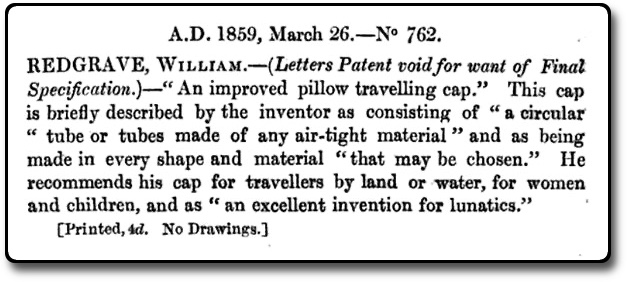
Posted By: Alex - Thu Nov 04, 2021 -
Comments (0)
Category: Inventions, Patents, Headgear, Nineteenth Century
Device to prevent mouth breathing
In 1920, Richard Jefferies was granted a patent for "a simple and practical device which will eliminate the habit of breathing through the mouth and at the same time will assist in harmonizing the facial features of the wearer, by more evenly balancing the muscles of expression."His invention consisted of a piece of adhesive-backed silk placed over the mouth.
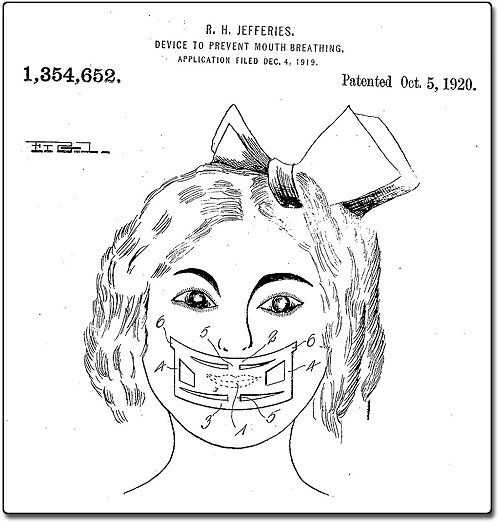
I was vaguely aware that mouth breathing is considered a bad habit, but I wasn't aware that "mouth taping" continues to be a common remedy for it.
For instance, one can buy SomniFix Sleep Strips, which look like they're a slightly updated version of Jefferies' invention.
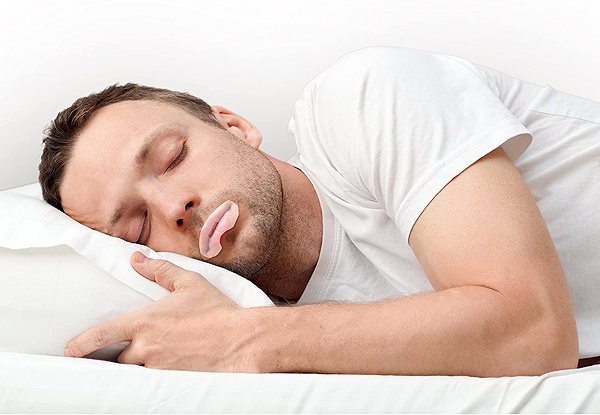
Posted By: Alex - Wed Oct 27, 2021 -
Comments (1)
Category: Health, Inventions, Patents, 1920s, Face and Facial Expressions
Alfred Schmitz’s Casket with Internal Body Supports
A casket designed for upright burial. From Schmitz's 1975 patent:In the past, caskets and vaults have been buried in a substantially horizontal position. Burial space, especially in urban areas, is becoming more scarce. A solution to such a problem may be found in burying caskets in a substantially vertical position. With such burial techniques, the amount of space required for each burial is substantially reduced.
While previously known caskets could be buried vertically, rather than horizontally, it should be realized that their use might be found distasteful by those who have been close to the party to be buried. An objection to the use of prior caskets may be found in the fact that in prior caskets generally there is nothing to support the body against shifting toward the foot end of the casket when buried in an upright position. Thus, if a conventional casket is tipped upright the body would slump to the foot end of the casket.
Related post: Upright Burial

Posted By: Alex - Thu Oct 21, 2021 -
Comments (0)
Category: Death, Inventions, Patents, 1970s
Budd-Michelin Rubber-Tire Trains
The Wikipedia page.Long informative article here (a PDF).
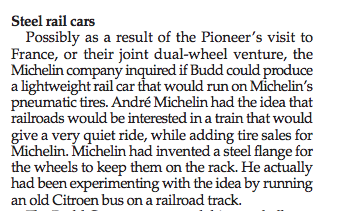
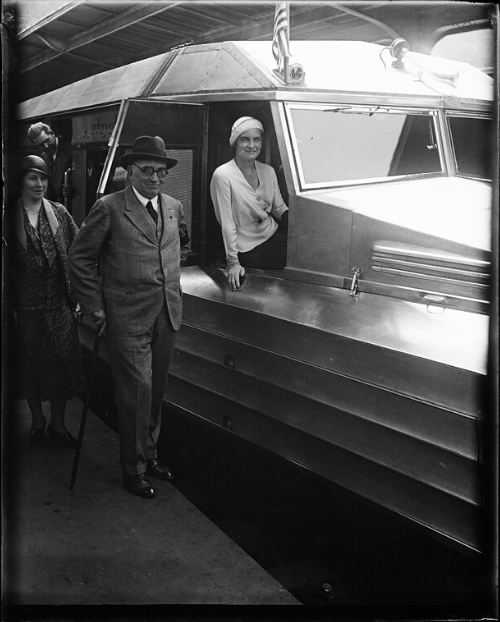
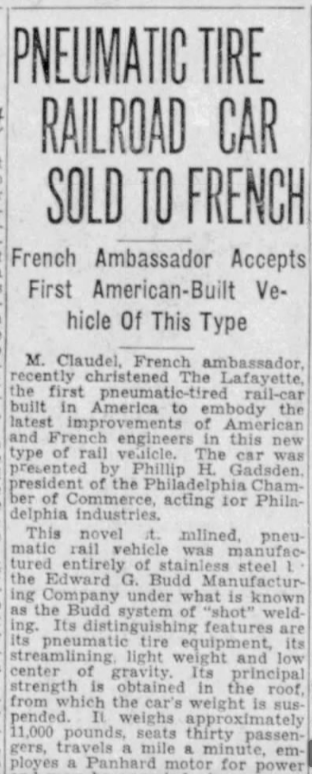
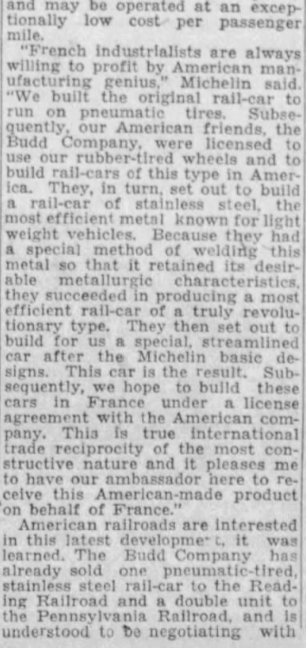
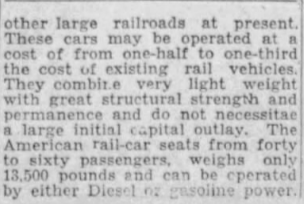
Newspaper source: The Fresno Bee (Fresno, California) 25 May 1932, Wed Page 13
Posted By: Paul - Wed Oct 13, 2021 -
Comments (2)
Category: Inventions, 1930s, Europe, North America, Trains
Scott Perky’s Bi-Directional Text
Henry Perky invented shredded wheat. His son, Scott, was also an inventor, though not as famous. He invented and patented a bi-directional, symmetrical font which could be read from left-to-right or right-to-left.
Perky's idea was that this would allow one to read a line of text from left to right, and then read the next line right to left, without having to move the eye back to the beginning of the line. This, he claimed, would reduce "brain fag":
It is hardly necessary to allude to the strain upon the eyes and brain, which results from much reading. To students, researchers and others whose lives are cast among books, any device which promises to facilitate reading in such wise as to lessen fatigue of the optical tract, and consequent headache and brain fag, will appear of unusual importance.
Randy Ludacer of Beach Packaging Design took the time to set the first three lines of Perky's patent in the bi-directional font, so you can experience what it would be like to read it:

Posted By: Alex - Fri Oct 08, 2021 -
Comments (5)
Category: Inventions, Patents, Languages, 1900s
The Gnathograph
The Gnathograph, or 'dental articulator', was the invention of Los Angeles dental surgeon Beverly McCollum. He was also the founder, in 1926, of the Gnathologic Society.The name 'Gnathograph' derived from 'gnathology,' this being the study of the jaw and masticatory system, from the greek word 'gnathos' meaning 'jaw'.

"The formidable contraption shown in the mouth of Miss Pearl Nord is a gnathograph, invented by Dr. Beverly B. McCollum of Los Angeles and demonstrated before the chicago Dental Society. It records direction of bite and fit of teeth and accurately guides a dentist in straightening crooked teeth or fitting inlays, crowns, bridges and plates."
image source: Agi Haines

The band Femur used the image above from Popular Science as the cover art for their album Red Marks.

Posted By: Alex - Sun Oct 03, 2021 -
Comments (0)
Category: Inventions, Patents, 1930s, Teeth
Boiled Fish Paste Crust Pizza
In 2014, the Korean patent office granted a patent for "a manufacturing method of boiled fish paste crust pizza."Doesn't sound appetizing to me, but perhaps boiled fish paste is popular in Korea.

Posted By: Alex - Mon Sep 06, 2021 -
Comments (1)
Category: Inventions, Patents, Junk Food
Captain Yancey and His Fabulous Autogyro
Source of clipping: Quad-City Times (Davenport, Iowa) 03 Jul 1931, Fri Page 1
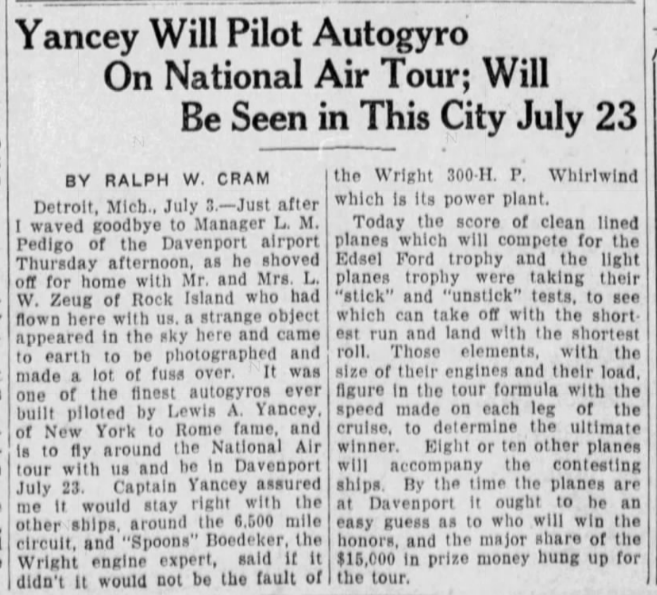
Good article here.
The Pitcairn PCA-2 autogyro was developed in 1931 and proved to be a reliable, unique aircraft. The rotor at its top was unpowered and it flew more like a fixed wing aircraft than a helicopter, based on the power from its radial engine on the nose. Once at speed, the rotor spun based on aerodynamic forces alone thus generating lift. It was an amazing sight and attracted crowds wherever it flew. By April of 1931, the autogyro had flown across the United States at the hands of John M. Miller, had landed on the White House lawn (by test pilot Jim Ray), and had soared to a new altitude record of 18,415 feet (this being Amelia Earhart’s record).
Seizing upon the press interest in the design, the Champion Spark Plug company purchased one and painted the sides with their logo and named it “Miss Champion”. It was the perfect flying billboard. After hiring Captain Lewis “Lew” Yancey, a former Naval Lieutenant and USCG officer who was a maritime captain, they directed that he fly the nation on an advertising tour. By the end of 1931, Captain Yancey had flown the autogyro 6,500 miles, transiting 21 states and touching down in 38 cities around the nation. Yet the Champion Spark Plugs company still wanted more attention — and thus they asked him to beat Amelia Earhart’s altitude record as well.
Posted By: Paul - Sun Sep 05, 2021 -
Comments (1)
Category: Inventions, Publicity Stunts, World Records, Advertising, Air Travel and Airlines, 1930s
Banana-Shaped Writing Device
Kia Scudder of San Antonio, Texas was recently granted Patent No. 11077701 for a "banana shaped writing device and method." From the patent:

Posted By: Alex - Fri Sep 03, 2021 -
Comments (2)
Category: Inventions, Patents, Bananas
The Reid Flying Submarine
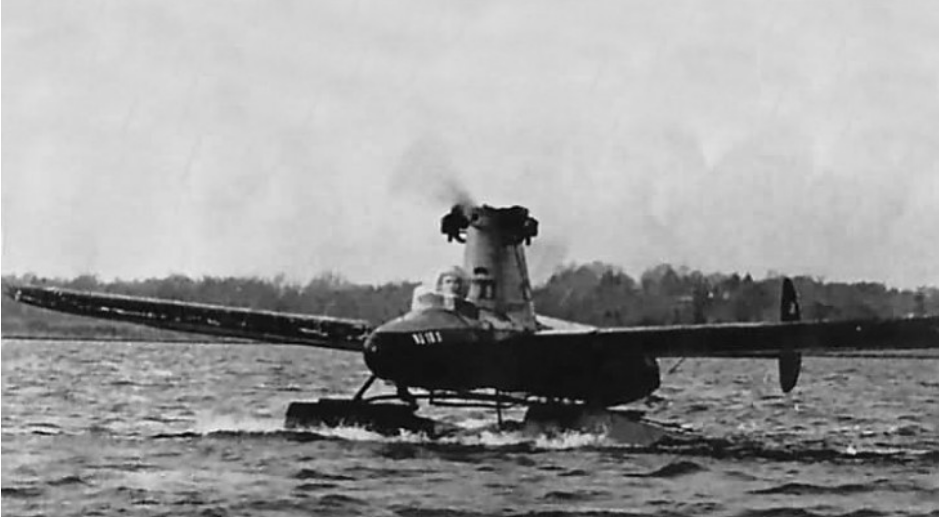
More pix and article here.
It wasn't a high-tech machine, despite its abilities. In the air it was powered by a 65 horsepower four-cylinder Lycoming engine. While underwater a 1-horsepower electric motor provided propulsion. Conversion from aircraft to submarine was a clumsy affair. The pilot first had to remove the propeller, and then cover the engine pylon with a rubber diving bell to keep the engine dry. The pilot used an aqualung to breathe. Maximum depth was roughly 10 to 12 ft (3.5 metres).
From THE SATURDAY EVENING POST for January 1, 1966.
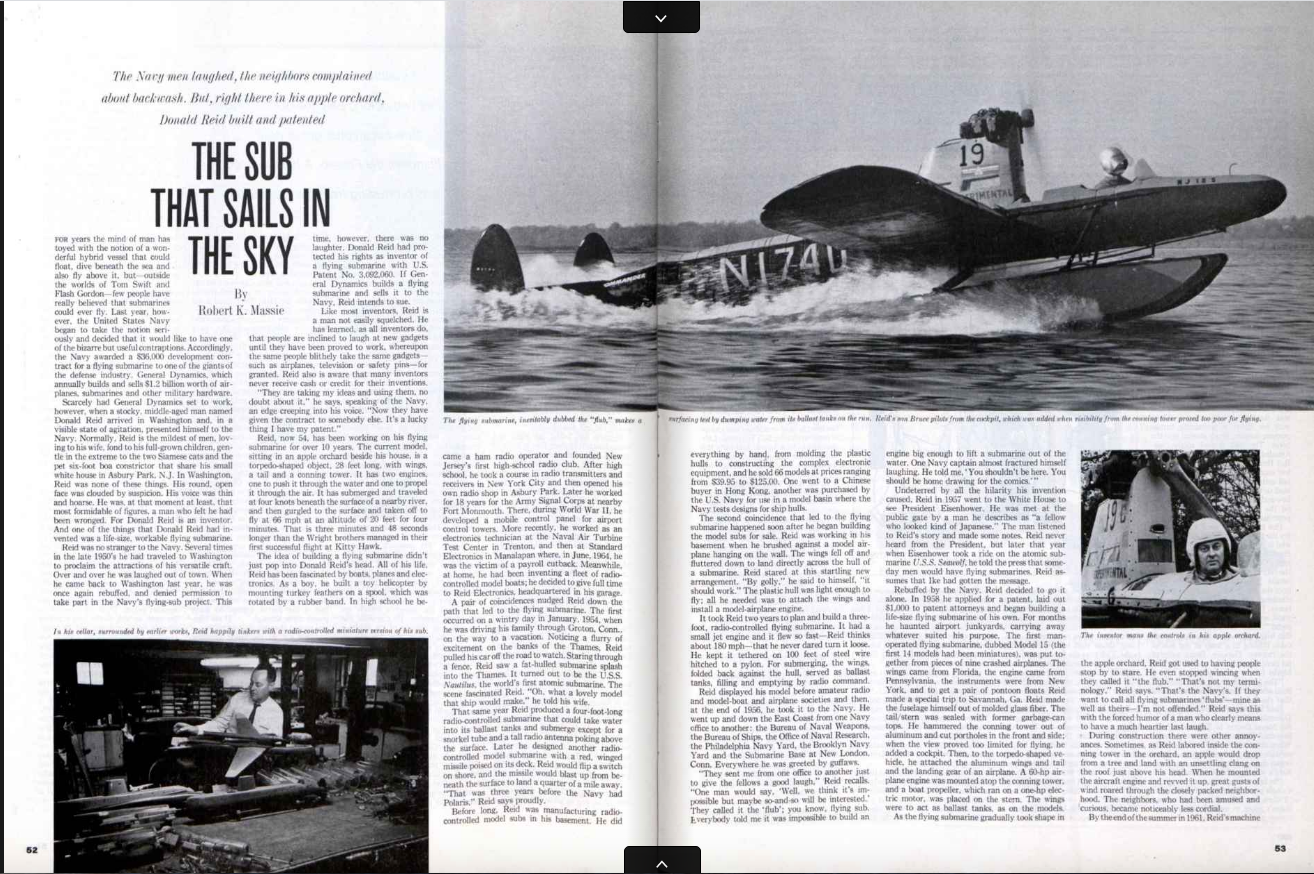
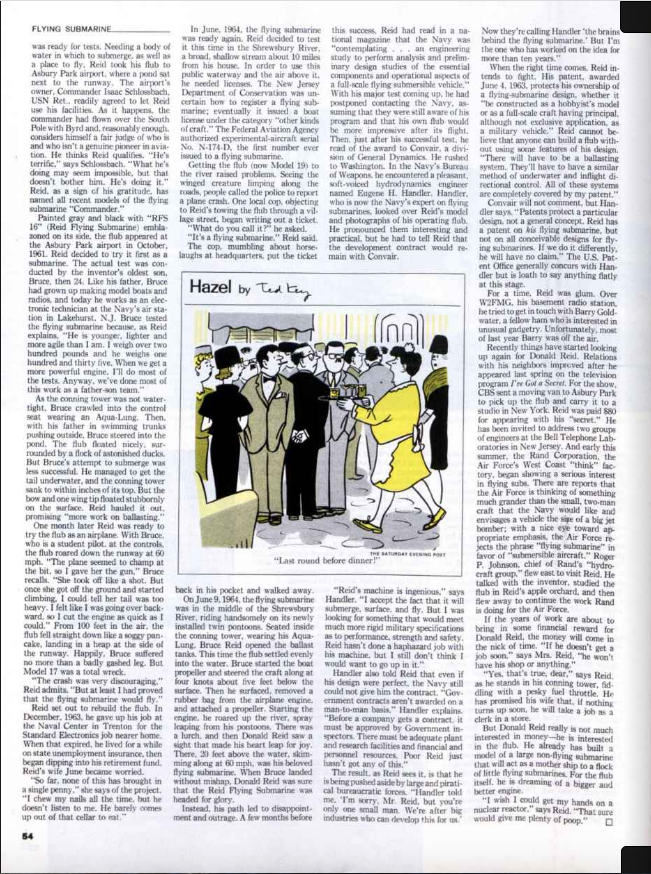
Posted By: Paul - Sat Aug 21, 2021 -
Comments (1)
Category: Death, Disasters, Inventions, Oceans and Maritime Pursuits, Air Travel and Airlines, 1960s

| Who We Are |
|---|
| Alex Boese Alex is the creator and curator of the Museum of Hoaxes. He's also the author of various weird, non-fiction, science-themed books such as Elephants on Acid and Psychedelic Apes. Paul Di Filippo Paul has been paid to put weird ideas into fictional form for over thirty years, in his career as a noted science fiction writer. He has recently begun blogging on many curious topics with three fellow writers at The Inferior 4+1. Contact Us |




